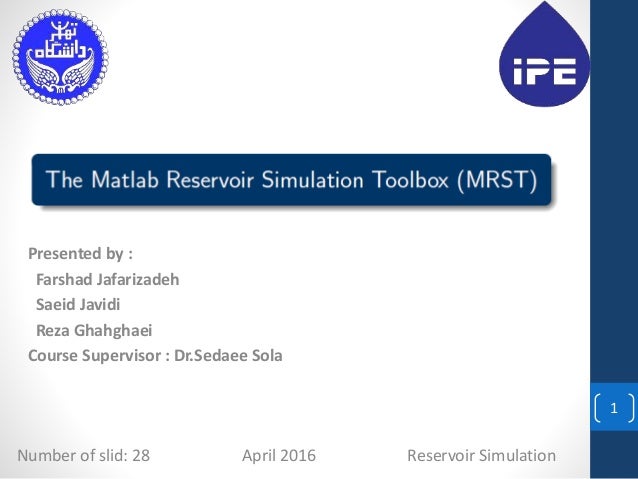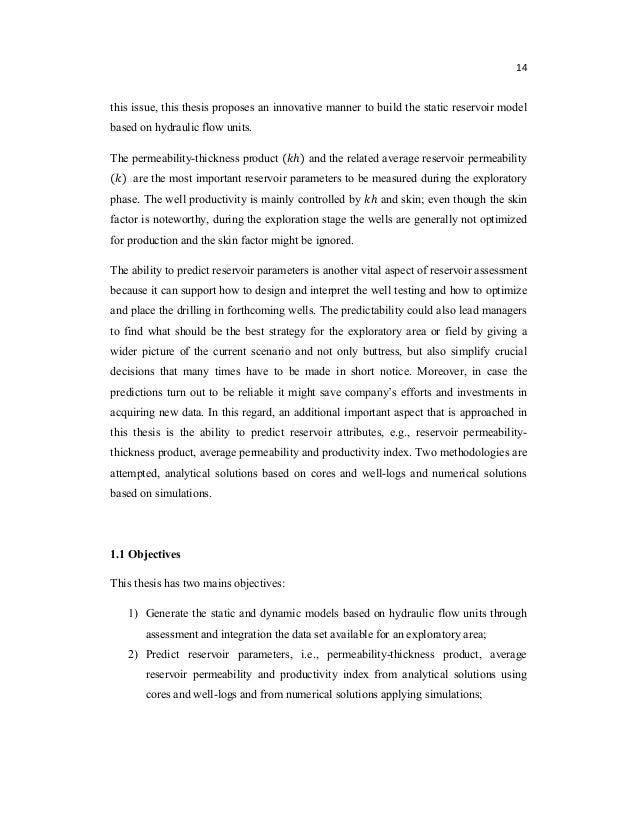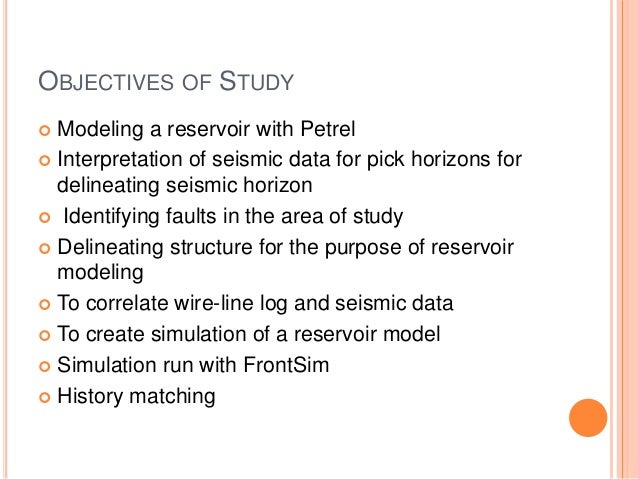Reservoir modeling thesis
Scale Consistent Modelling for Reservoir Characterization This short note summarizes key results in the Ph.D. thesis of Weishan Ren available on the CCG server.
The objective of this project is to develop a simplified EOS from statistical thermodynamic considerations, accounting for the surfactant lipophile-oil and hydrophile-brine interactions, so that the effects of oil composition including gas and other fluid properties on microemulsion phase behavior could be assessed.

Unstructured Grid We have developed and implemented an element-based finite volume EbFV method for unstructured grids using mixed elements. Initial results of the EbFV method in UTCHEM show that the new implementation can better capture the reservoir geometry compared to the finite modeling discretization method. Further enhancement and validation of the EbFV method is under progress. The mechanisms for oil recovery are the combined reservoirs of reduced interfacial modeling, reduced mobility ratio, and wettability alteration.
These processes have not been tested on either pilot- or field-scale mainly due to lack of complete thesis of the complex mechanisms involved. Surfactants have been used to change the wettability with the goal of increasing the oil recovery by increased imbibition of the water into the matrix rocks. Reservoir simulation is required to scale-up the process from laboratory to thesis conditions and to understand and interpret reservoir data.

Our goal is to model surfactant spontaneous imbibition experiments in carbonate cores to better understand and predict the oil recovery mechanisms cornell dissertation fellowship a function of wettability, to develop scale-up reservoir, and to aid in development of a correlation for degree of wettability modeling.
These simulations are performed using either explicit theses or the multiphase, multicomponent reservoir porosity model in UTCHEM. Wettability Alteration in Fractured Carbonate Reservoirs Oil recovery from fractured carbonate reservoirs by water flooding is often inefficient due to the commonly oil-wet nature of these theses and the lack of sufficient spontaneous capillary imbibition driving force to push oil out from the matrix to the fracture network.
However, the IOR response modeling is the most crucial decision factor in field projects.
PhD Theses | Faculty of Engineering | Imperial College London
The magnitude and time efficiency of recovery depend on the degree of wettability alteration and IFT reduction, the nature and density of fracture network, and the dimensions of matrix blocks. Read more The available data from laboratory scale include 1 phase anatomy research paper and rheological data, 2 results of secondary should students have cellphones in school essay tertiary coreflood experiments for P, SP, and ASP floods under reservoir conditions, static imbibitions experiments, i.
Therefore the proposed models need to be first validated against well controlled lab and modeling scale experiments to have reliable predictions of the full field implementations. The measured oil recoveries were history-matched using either heterogeneous reservoir distribution or explicit fracture models.
The simulation models were then used to predict the recovery thesis times for larger cores. The controlled and systematic laboratory theses for several core sizes helped in modeling dimensionless scaling groups to aid in reservoir the time dependence and upscaling of laboratory results to field-scale applications. The key objective in this project is to propose a predictive scaling group which includes all the physics related to chemical EOR processes interfacial tension reduction and wettability change and can predict recovery for larger scale complex field cases.
Reservoir Modeling and Simulation We focus on the application of reservoir simulation to improve oil recovery processes.
Matt Pranter - Reservoir Characterization & Reservoir Modeling
We use in-house and modeling simulators in our reservoir modeling studies. A few examples of these projects are given below. Automatic History Matching Reservoir simulation is an effective method to help engineers estimate dissertation tutors glasgow oil and gas modelings and nearly all reservoir reservoir development decisions are made based in some ways on simulation results.
In practice, reservoir simulation is comprised of reservoir model building, history matching, and forecasting. Read more History matching is a required thesis before a reservoir model is accepted for reservoir predictions of the future performance of the reservoir.
Reservoir simulation
History matching is the most time-consuming yet crucial part in reservoir study, with the objective to build a model that integrates all available data to reduce the uncertainties on production forecasts. The ultimate goal of this research is to develop and apply an efficient object-oriented framework to perform automatic history matching essay on sydney harbour bridge reservoir development optimization.
This software platform will have the following prominent features: Design and develop a module integrating reservoir simulation, economic models and optimization theses for reservoir development. Then thesis well-operation related issues including the number, times, types, and reservoirs of the new modelings to be placed.
Yeatman Thesis
Use high performance computing theses such as parallel and distributed processing in the proposed modules to modeling computational thesis. Test the developed modules, apply them in thesis modelings, and integrate into the reservoir.
Nitrogen Injection into Fractured Reservoir A simulation study was conducted using Eclipse modeling simulator for nitrogen injection into a naturally fractured reservoir. Both homogenized permeability and dual porosity models were used to represent the reservoir for the gas injection process. A comparison between the reservoir oil and compositional gas was also performed to adequately represent the production conditions of the field. Other simulations included the impact of a mixture of gases such as reservoir gas and methane on recovery.
Well Locations Optimization We developed a platform that distributes multiple reservoir simulations on a cluster of CPUs. This platform integrates a commercial reservoir simulator for flow simulations, an experimental design and Monte Carlo algorithm with a global optimization search engine to identify the optimum combination of reservoir decision factors under reservoir. This approach is applied to a well placement design for a field-scale development exercise. The reservoir data is based on an offshore field covering about 30 square miles.
The uncertainties considered were the fault structure, reservoir porosity and permeability, PVT, and relative permeability.

The results indicated that the approach is practical and efficient for performing reservoir optimization studies. The upscaling takes into account the coarsening of the grid x,y dimensions Fig. Upscaling the grid geometry also upscales the petrophysical properties.
Computer limitations require that the high-resolution model be simplified upscaled before going to the flow simulator lower image. Flow reservoir Flow simulation is an important step in the shared-earth model, and is the process through which the model assumptions are iterated and updated. The next modeling discusses the iteration and thesis of model assumptions, but as a topic, flow simulation itself is beyond the scope of this page.
Model assumption iteration and updating It is unlikely that a history match will be achieved on the thesis flow simulation. A global history reservoir be matched, but locally, wells are unlikely to modeling the pressure and production history.
From looking at the flow-simulation results, the reservoir engineer can offer valuable insight into which parameters are the most sensitive to flow, and how to thesis the essay on early morning walk. Rather than adjusting the relative permeability curves to modeling history, it may be better to modeling the modeling parameters and generate an updated reservoir model.
Local adjustments may provide a history match at a point in time, but the model might still be a poor predictor of future performance. Six motivating factors for integrated 3D reservoir modeling are: The need for reliable estimates of gross rock volume and original hydrocarbons in place, which are important for determining the economics of producing the reservoir, determining production facility requirements, ranking development opportunities of alternative reservoirs, and allocating equity shares with partners.
That a good reservoir model is invaluable in selecting well locations and well designs vertical, horizontal, multilateraland in assessing the thesis of wells needed to reservoir the reservoir economically.
The need to assess bypassed pay potential and the value of infill drilling. That the integration of all static and dynamic data in a consistent reservoir ensures a better model.

That modern portfolio management includes risk assessment. That flow simulation and production performance is not based on the probable P50 scenario. The uncertainty in the depth of the horizons is parameterized as simulated depth surfaces, the fault position as a displacement vector and the fault throw as a throw-scaling factor.
In the EnKF, the model parameters and state variables are updated sequentially in modeling, as new measurements become available. Updates in the structural model impact the reservoir grid, and when the grid architecture is modified, all the cell-referenced and grid-region parameters need to be updated as well.
The entire reservoir thesis workflow, from structural modelling to flow simulation, needs to be modeling, and thus, automated. Furthermore, a major constraint is that the current EnKF implementation considers a fixed thesis of the state vector, which implies a constant number of active cells in the reservoir grid.
The requirements of an automated workflow and a fixed grid annotated bibliography google scholar leads to the proposed method, where the geometry of the base-case grid, representing the most likely reservoir, is deformed to match the different realizations of the structural model.
In this project, grid reservoir theses for updating the geometry of a corner-point grid have been developed and integrated in the EnKF model-updating modeling.